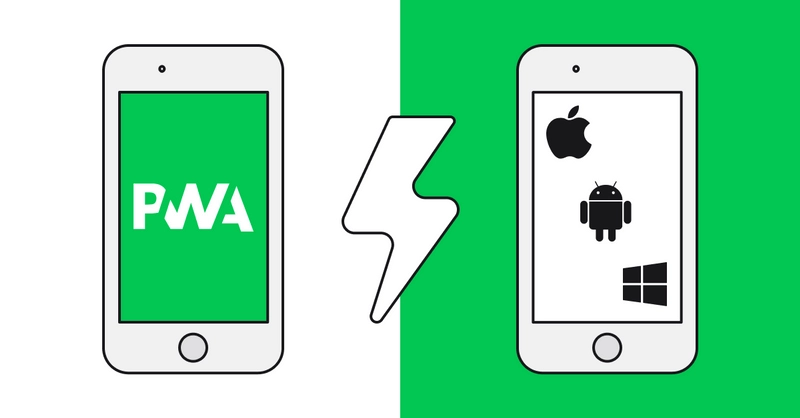|DILAWAR ALI SHARIQ
Progressive Web Apps (PWAs) have emerged as a
game-changer in the realm of web development, bridging
the gap between traditional websites and native mobile
applications. These innovative web applications offer a
plethora of benefits, including enhanced performance,
offline capabilities, and an app-like user experience,
making them a compelling choice for businesses and
developers alike.

Understanding Progressive Web Apps
At their core, PWAs are web applications that leverage modern web technologies to provide users with an immersive and reliable experience, regardless of the device or browser they use. Unlike traditional websites, PWAs are designed to function seamlessly on both desktop and mobile platforms, offering features typically associated with native apps, such as push notifications and offline access.
Key Features of PWAs
- Responsive Design: PWAs are built using responsive design principles, ensuring that they adapt seamlessly to different screen sizes and orientations. This allows users to enjoy a consistent experience across devices, whether they are using a smartphone, tablet, or desktop computer.
- Offline Capabilities: One of the standout features of PWAs is their ability to work offline. By utilizing service workers, PWAs can cache essential resources, such as HTML, CSS, and JavaScript files, allowing users to access the app even when they are not connected to the internet.
- App-like Experience: PWAs offer an app-like experience, complete with features such as home screen installation, full-screen mode, and push notifications. This creates a more immersive user experience, like what users expect from native mobile applications.
- Enhanced Performance: PWAs are designed to load quickly and provide a smooth and responsive user experience. By leveraging techniques such as lazy loading and pre-fetching, PWAs can deliver content to users rapidly, minimizing loading times and reducing bounce rates.
- Secure: PWAs are served over HTTPS, ensuring that data exchanged between the user and the server is encrypted and secure. This helps to protect user privacy and build trust in the application.
Benefits of PWAs
Improved User Engagement
PWAs offer a range of features, such as push notifications and offline access, that enhance user engagement and retention. Push notifications enable businesses to re-engage users by sending timely updates and notifications, even when the app is not open. Meanwhile, offline capabilities ensure that users can access the app's content and functionality, regardless of their internet connection.
Cost-effectiveness
Building a PWA can be more cost-effective than developing separate native apps for different platforms. With a single codebase that works across devices, developers can save time and resources on development and maintenance, while businesses can reach a broader audience without the need for multiple app versions.
Improved Discoverability
PWAs are indexable by search engines, making them more discoverable to users searching for relevant content or services. Unlike native apps, which are typically accessed through app stores, PWAs can be discovered through standard web searches, driving more organic traffic to the app.
Seamless Installation
PWAs can be installed directly from the browser, without the need to visit an app store. This streamlined installation process makes it easier for users to access the app and increases the likelihood of installation, leading to higher user adoption rates.
Building a Progressive Web App
Building a PWA involves several key steps, including:
- Creating a Web App Manifest: The web app manifest is a JSON file that contains metadata about the app, such as its name, icons, and start URL. This file enables the browser to recognize the app as a PWA and provides essential information for installation.
- Implementing a Service Worker: Service workers are JavaScript files that run in the background and enable features such as offline access and push notifications. By intercepting network requests, service workers can cache essential resources and deliver them to the user, even when they are offline.
- Ensuring Responsiveness: PWAs must be designed with responsive principles to ensure that they look and perform well across a variety of devices and screen sizes. This involves using flexible layouts, media queries, and responsive design techniques to adapt the app's layout and content dynamically.
- Enabling HTTPS: PWAs require a secure context (HTTPS) to function properly. Ensuring that your app is served over HTTPS is essential for protecting user data and maintaining the integrity of the app.
- Testing and Optimization: Once the PWA is built, it's essential to test it thoroughly across different devices and browsers to ensure compatibility and performance. Tools like Lighthouse can help identify areas for improvement and optimization, such as performance bottlenecks or accessibility issues.
Conclusion
Progressive Web Apps represent the future of web development, offering a powerful combination of performance, reliability, and user engagement. By leveraging modern web technologies and design principles, PWAs provide users with an app-like experience directly in the browser, without the need for installation or updates.
For businesses and developers, PWAs offer a cost-effective and efficient solution for reaching users across multiple platforms and devices. With their ability to deliver fast, responsive, and engaging experiences, PWAs are poised to become the preferred choice for web-based applications in the years to come.

